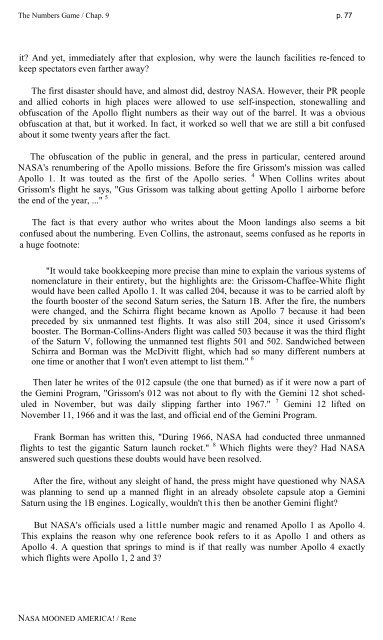Rene-NASA-Mooned-America
Rene-NASA-Mooned-America
Rene-NASA-Mooned-America
Create successful ePaper yourself
Turn your PDF publications into a flip-book with our unique Google optimized e-Paper software.
The Numbers Game / Chap. 9 p. 77<br />
it And yet, immediately after that explosion, why were the launch facilities re-fenced to<br />
keep spectators even farther away<br />
The first disaster should have, and almost did, destroy <strong>NASA</strong>. However, their PR people<br />
and allied cohorts in high places were allowed to use self-inspection, stonewalling and<br />
obfuscation of the Apollo flight numbers as their way out of the barrel. It was a obvious<br />
obfuscation at that, but it worked. In fact, it worked so well that we are still a bit confused<br />
about it some twenty years after the fact.<br />
The obfuscation of the public in general, and the press in particular, centered around<br />
<strong>NASA</strong>'s renumbering of the Apollo missions. Before the fire Grissom's mission was called<br />
Apollo 1. It was touted as the first of the Apollo series. 4 When Collins writes about<br />
Grissom's flight he says, "Gus Grissom was talking about getting Apollo 1 airborne before<br />
the end of the year, ..." 5<br />
The fact is that every author who writes about the Moon landings also seems a bit<br />
confused about the numbering. Even Collins, the astronaut, seems confused as he reports in<br />
a huge footnote:<br />
"It would take bookkeeping more precise than mine to explain the various systems of<br />
nomenclature in their entirety, but the highlights are: the Grissom-Chaffee-White flight<br />
would have been called Apollo 1. It was called 204, because it was to be carried aloft by<br />
the fourth booster of the second Saturn series, the Saturn 1B. After the fire, the numbers<br />
were changed, and the Schirra flight became known as Apollo 7 because it had been<br />
preceded by six unmanned test flights. It was also still 204, since it used Grissom's<br />
booster. The Borman-Collins-Anders flight was called 503 because it was the third flight<br />
of the Saturn V, following the unmanned test flights 501 and 502. Sandwiched between<br />
Schirra and Borman was the McDivitt flight, which had so many different numbers at<br />
one time or another that I won't even attempt to list them." 6<br />
Then later he writes of the 012 capsule (the one that burned) as if it were now a part of<br />
the Gemini Program, "Grissom's 012 was not about to fly with the Gemini 12 shot scheduled<br />
in November, but was daily slipping farther into 1967." 7 Gemini 12 lifted on<br />
November 11, 1966 and it was the last, and official end of the Gemini Program.<br />
Frank Borman has written this, "During 1966, <strong>NASA</strong> had conducted three unmanned<br />
flights to test the gigantic Saturn launch rocket." 8 Which flights were they Had <strong>NASA</strong><br />
answered such questions these doubts would have been resolved.<br />
After the fire, without any sleight of hand, the press might have questioned why <strong>NASA</strong><br />
was planning to send up a manned flight in an already obsolete capsule atop a Gemini<br />
Saturn using the 1B engines. Logically, wouldn't this then be another Gemini flight<br />
But <strong>NASA</strong>'s officials used a little number magic and renamed Apollo 1 as Apollo 4.<br />
This explains the reason why one reference book refers to it as Apollo 1 and others as<br />
Apollo 4. A question that springs to mind is if that really was number Apollo 4 exactly<br />
which flights were Apollo 1, 2 and 3<br />
<strong>NASA</strong> MOONED AMERICA! / <strong>Rene</strong>


